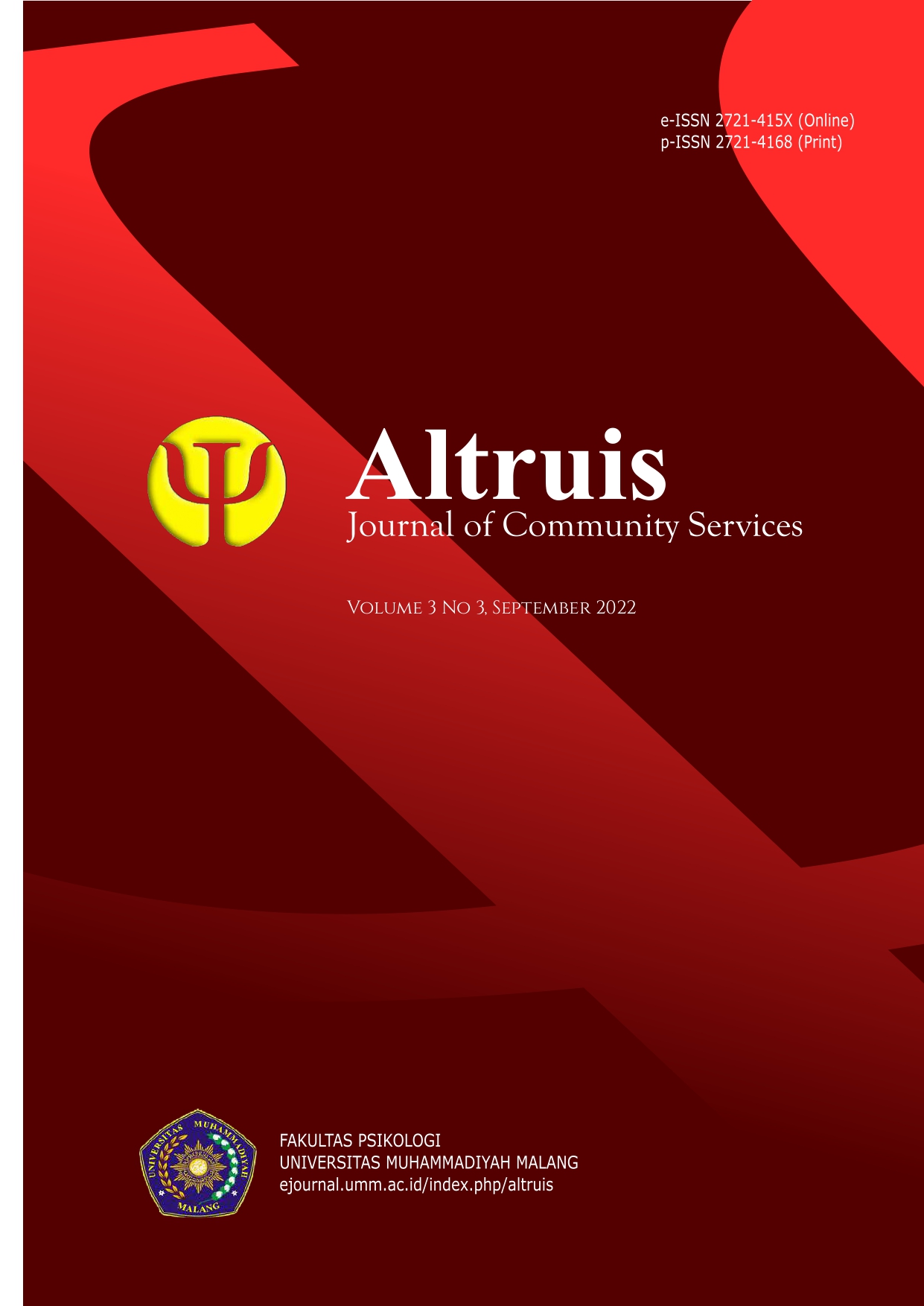Meningkatkan kemampuan berbicara Bahasa Inggris anak melalui cerita bergambar
DOI:
https://doi.org/10.22219/altruis.v3i3.22434Keywords:
English, Picture book, SpeakingAbstract
In learning English, speaking aspect has an important role when communicating. The development of children's language skills underlies the ability to read. Tthe more they read, the easier it will be for children to understand writing, and the more fluent their speaking skills will be. However, in developing their English speaking, children have difficulty because of the limited vocabulary. Heving difficulty in expressing ideas and lack of courage to speak because they are afraid of being wrong are factors that prevent children from speaking English well. In addition to the factors mentioned above, internal factors, such as the lack of seriousness of children in learning English itself as well as inadequate learning methods and lack of media are obstacles for children in learning English. This is felt by the children of TPA RT 004/RW 04 Pabuaran Tumpeng Tangerang. The low interest in reading in the environment where they live is the basis for the lack of development of language skills, especially English. Therefore, the Community Service team (PKM) Universitas Pamulang (UNPAM) offers a problem solution in the form of teaching English with the method of storytelling by using digital media with illustrated stories in English. From the results of the PKM activities at Taman Alquran Pabuaran Tumpeng with a series of activities, it seems that the children are happy, interested, and active. If proves that the use of storytelling method through pictures can improve children's English speaking skills.
Downloads
References
Arsjad, M. G. (2005). Pembinaan Kemampuan Berbicara Bahasa Indonesia. PT. Gelora Aksara Pratama.
Balai Pustaka. (2016). Kamus Besar Bahasa Indonesia. PT Balai Pustaka
Bettelheim, B. (2011). Uses of Enchantment. Vintage Books
Djiwandono, M. S. (1996). Tes dalam pengajaran. ITB
Emzir. (2013). Metodologi Penelitian Pendidikan Kuantitatif dan Kualitatif. PT. Raja Grafindo Persada
Hendrikus, D. W. (1991). Retorika. Kanisius.
Indriana, D. (2011). Ragam Alat Bantu Media Pengajaran. Diva Press
Kern, R. (2000). Literacy and Language Teaching. Oxford University Press
Kumara, A. (2014). Kesulitan Berbahasa Pada Anak. Kanisius.
Margono, S. (2010). Metodologi Penelitian Pendidikan. Rineka Cipta
Maylitha, E. ., Lestari, T. (2021).Story telling sebagai sarana perkembangan bahasa pada anak. Jurnal Pendidikan Tambusai, 5(1), 1499–1502. https://www.jptam.org/index.php/jptam/article/view/1128
Tarigan, H. G. (2015). Berbicara sebagai suatu keterampilan berbicara. Angkasa.
Priyono, K. (2001). Terampil mendongeng. Gramedia Widiasarana Indonesia.
Rahimi, M. & Yadollahi, S. (2017). Effects of offline vs. online digital storytelling on the development of EFL learners’ literacy skills. Cogent Education, 4:1, https://doi.org/10.1080/2331186X.2017.1285531
Ratnasari E. M & Zubaedah E. (2019). Pengaruh penggunaan buku cerita anak bergambar terhadap kemampuan berbicara anak. Scholaria: Jurnal Pendidikan dan Kebudayaan 9(3), 267-275. https://doi.org/10.24246/j.js.2019.v9.i3.p267-275
Satriani, I. (2019). Storytelling in teaching literacy: Benefits and challenges. English Review: Journal of English Education, 8(1), 113-120. https://doi.org/10.25134/erjee.v8i1.1924
Downloads
Published
How to Cite
Issue
Section
License
Copyright (c) 2022 May Triranto Maharini, Wirhayati Wirhayati, Erni Susanti Nainggolan, Anita Sari

This work is licensed under a Creative Commons Attribution-ShareAlike 4.0 International License.
Authors who publish in Altruis agree to the following terms:
- For all articles published in Altruis, copyright is retained by the authors. Authors give permission to the publisher to announce the work with conditions. When the manuscript is accepted for publication, the authors agree to automatic transfer of the publishing right to the publisher.
- Authors retain copyright and grant the journal right of first publication with the work simultaneously licensed under a Creative Commons Attribution-ShareAlike 4.0 International License that allows others to share the work with an acknowledgment of the work's authorship and initial publication in this journal.
- Authors are able to enter into separate, additional contractual arrangements for the non-exclusive distribution of the journal's published version of the work (e.g., post it to an institutional repository or publish it in a book), with an acknowledgment of its initial publication in this journal.
- Authors are permitted and encouraged to post their work online (e.g., in institutional repositories or on their website) prior to and during the submission process, as it can lead to productive exchanges, as well as earlier and greater citation of published work (See The Effect of Open Access).
This work is licensed under a Creative Commons Attribution-ShareAlike 4.0 International License.


